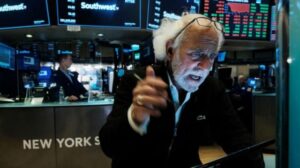The week began with heavy losses across all indices, with Wall Street extending the losses of the previous sessions as a resurgence of analysts’ worst fears about the US economy’s performance triggered sharp swings in markets internationally.
However, compared to the dramatic start to the session, with the Nasdaq losing over 6% and the S&P 500 down over 4%, the losses were… somewhat contained.
Specifically, the Dow Jones cut the thread by falling 1,033 points or 2.60% to 38,703, the S&P 500 was eventually down -3% to 5,186 and the Nasdaq took a 3.43% “plunge” to 16,200.
For both the Dow and the S&P 500 it was the worst session in nearly two years. At the same time the Nasdaq is officially in technical correction territory, as it is at least 10% below its recent all-time high.
Specifically, the Nasdaq’s gap from its recent high is moving to 13.7%, while now the S&P 500 is 8.7% below its high and the Dow is down about 6.3%.
At the same time, the so-called VIX fear index, although in the early hours it soared to its highest point in four years at 65.73 points, ended up high again at 38.22 points, its highest point since January 2022.
A key factor in the intense pressure on Wall Street and beyond was the recent disappointing data from the US labour market, which combined with a number of still-sluggish figures have fuelled investor fears that the strength of the US economy is beginning to buckle under the weight of consistently high interest rates. Thus, the scenario of a smooth landing of the economy may turn into a bumpy landing or even a recession.
For now, of course, the structural evidence is not consistent with the immediate threat of a recession. But the market is concerned that the overly cautious strategy adopted by the Fed in delaying to cut rates has now triggered downward pressures on the economy that may gradually lead to this scenario.
Significantly, in early 2024, no analyst was talking about even a slim chance of the US economy retreating into recession, when now Goldman Sachs has indicatively raised the chances of a recession to 25%.
“The Fed probably realizes now that it made a mistake last week. It delayed too long in taking action,” economist Campbell Harvey commented to Bloomberg, referring to the FOMC’s decision to keep interest rates unchanged again, leaving the … big stuff for the September meeting.
It’s no coincidence that to… exorcise the panic, traders started betting on the possibility of an emergency Fed intervention in August to calm the market jitters. Similarly, many analysts raised the odds of a more dynamic first rate cut, by 50 basis points, at the scheduled September 18 meeting.
At the equity level, technology and semiconductor companies had taken the role of the saddest protagonist in the decline, registering the biggest pressures.
In fact, in the early hours, losses for the famous Magnificent Seven were in the range of 10% or more, although gradually their decline narrowed. To illustrate, Nvidia (which started at -14.5%) lost about 7% taking its losses from its most recent high to 29%, while Tesla and Apple lost close to 5%.
The latter in particular was also particularly pressured by the news that equity guru Warren Buffett has halved Berkshire Hathaway’s stake in the tech giant.
Crypto stocks were also in the crosshairs, under the weight of Bitcoin’s plunge below the $50,000 mark for the first time since last February.
Among the few stocks that moved against the negative tide, Kellanova stood out, as the maker of snacks such as Pringles chips appears to be a target for a potential takeover by another industry giant, Mars. Tyson Foods also made gains after reporting strong quarterly results.
In the bond market, after also continuous and sharp fluctuations, the 10-year yield ended up falling to 3.771%, while the 2-year yield rose to 3.887.
Ask me anything
Explore related questions





